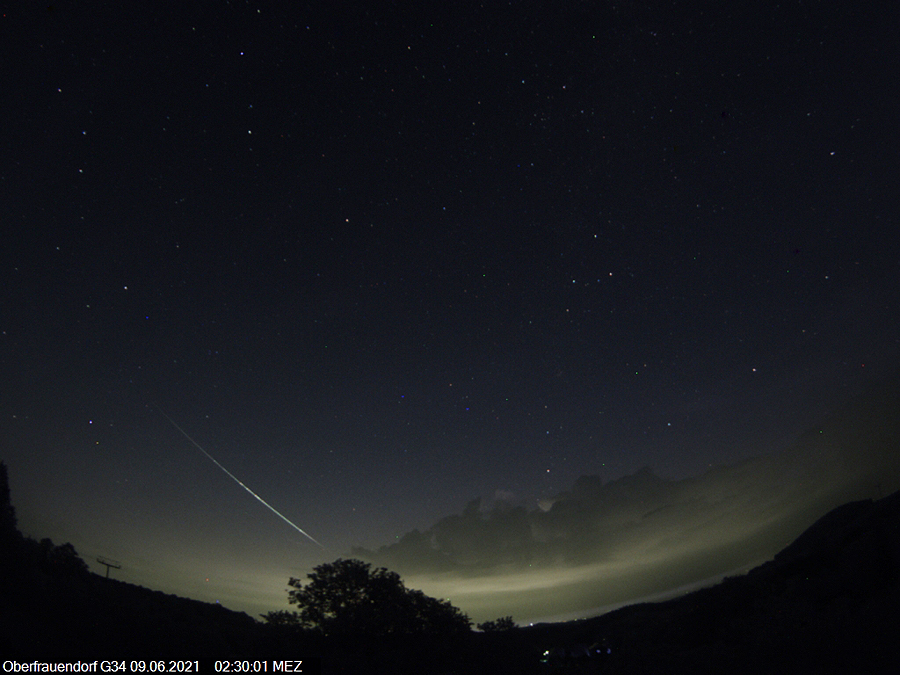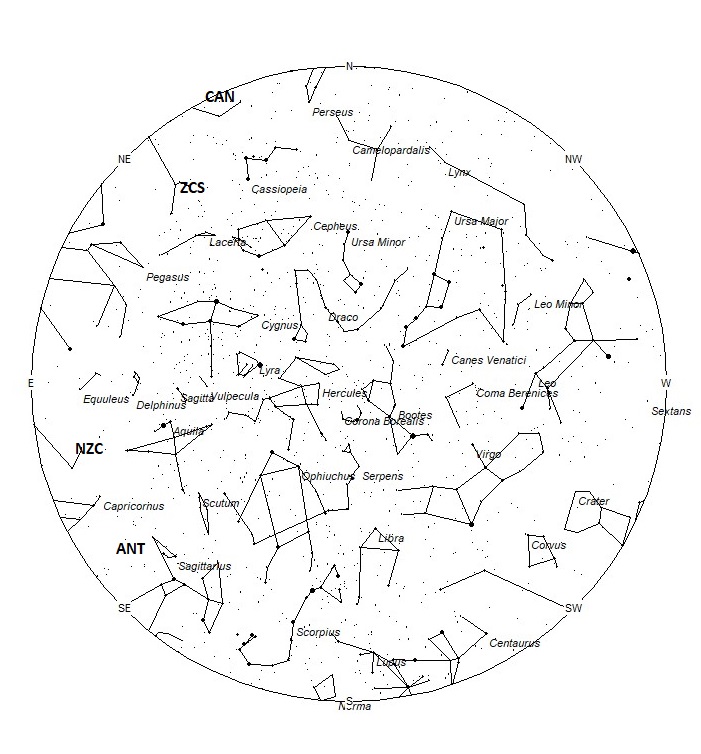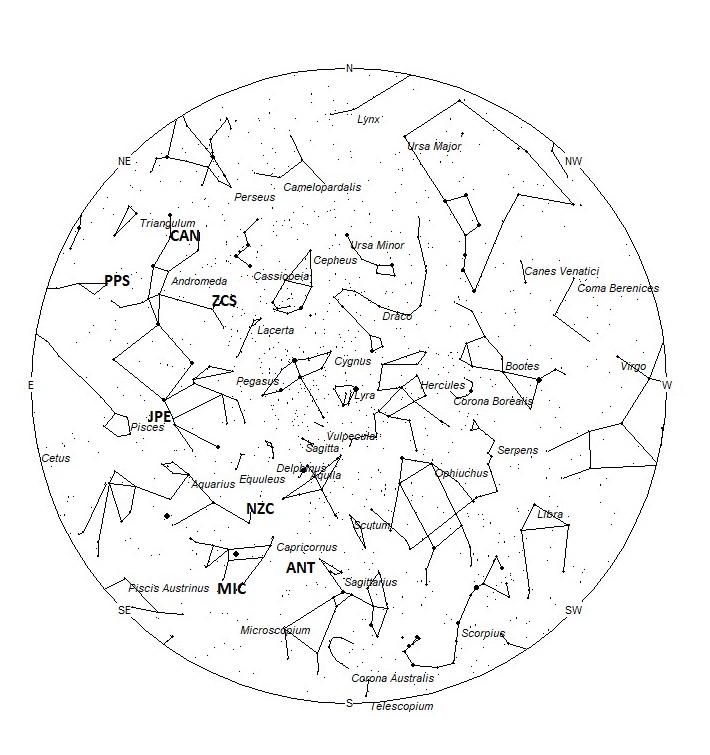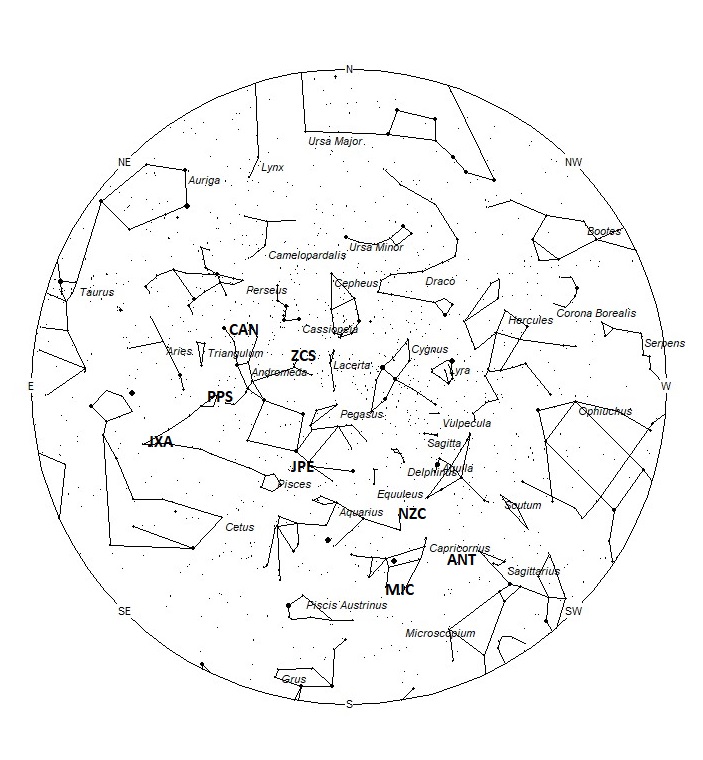 Tobias Felber captured this fireball low in the north at 02:30 UT (00:30 CEST) on June 9, 2021, from Glashütte Sachsen, Germany. For more information on this fireball visit: https://fireball.amsmeteors.org/members/imo_view/event/2021/3272 ©Tobias Felber
Tobias Felber captured this fireball low in the north at 02:30 UT (00:30 CEST) on June 9, 2021, from Glashütte Sachsen, Germany. For more information on this fireball visit: https://fireball.amsmeteors.org/members/imo_view/event/2021/3272 ©Tobias FelberDuring this period, the moon reaches its new phase on Friday July 9th. At that time the moon is located near the sun and is invisible at night. This weekend a bright crescent moon will illuminate the morning sky. Successful meteor watches can still be held at this time as long as you keep the moon well out of your field of view. As the week progresses the moon becomes thinner and less of a problem until it disappears entirely into the morning twilight late in the period. The estimated total hourly meteor rates for evening observers this week is near 2 as seen from mid-northern latitudes (45N) and 3 as seen from tropical southern locations (25S). For morning observers, the estimated total hourly rates should be near 7 as seen from mid-northern latitudes (45N) and 10 as seen from tropical southern locations (25S). The actual rates will also depend on factors such as personal light and motion perception, local weather conditions, alertness, and experience in watching meteor activity. Rates are reduced by moonlight during this period. Note that the hourly rates listed below are estimates as viewed from dark sky sites away from urban light sources. Observers viewing from urban areas will see less activity as only the brighter meteors will be visible from such locations.
The radiant (the area of the sky where meteors appear to shoot from) positions and rates listed below are exact for Saturday night/Sunday morning July 3/4. These positions do not change greatly day to day so the listed coordinates may be used during this entire period. Most star atlases (available at science stores and planetariums) will provide maps with grid lines of the celestial coordinates so that you may find out exactly where these positions are located in the sky. A planisphere or computer planetarium program is also useful in showing the sky at any time of night on any date of the year. Activity from each radiant is best seen when it is positioned highest in the sky, either due north or south along the meridian, depending on your latitude. It must be remembered that meteor activity is rarely seen at the radiant position. Rather they shoot outwards from the radiant, so it is best to center your field of view so that the radiant lies at the edge and not the center. Viewing there will allow you to easily trace the path of each meteor back to the radiant (if it is a shower member) or in another direction if it is sporadic. Meteor activity is not seen from radiants that are located far below the horizon. The positions below are listed in a west to east manner in order of right ascension (celestial longitude). The positions listed first are located further west therefore are accessible earlier in the night while those listed further down the list rise later in the night.
These sources of meteoric activity are expected to be active this week.
.
The center of the large Anthelion (ANT) radiant is currently located at 19:40 (295) -21. This position lies in eastern Sagittarius, 5 degrees east of the 3rd magnitude star known as Albaldah (pi Sagittarii A). Due to the large size of this radiant, Anthelion activity may also appear from western Capricornus as well as Sagittarius. This radiant is best placed near 0200 local Daylight Saving time (LDST), when it lies on the meridian and is located highest in the sky. Rates at this time should be near 1 per hour as seen from the Northern Hemisphere and 2 per hour as seen from south of the equator. With an entry velocity of 30 km/sec., the average Anthelion meteor would be of slow velocity.
The Northern June Aquilids (NZC) were discovered by Zdenek Sekanina in 1976. These meteors are active from June 26 through July 22 with maximum activity occurring on July 15. The radiant is currently located at 20:41 (310) -06. This area of the sky is located in western Aquarius, 2 degrees west of the faint star known as 3 Aquarii. This radiant is best placed near 0300 LDST, when it lies on the meridian and is located highest in the sky. Hourly rates at this time should be less than 1 no matter your location. With an entry velocity of 39 km/sec., the average meteor from this source would be of medium-slow velocity. An interesting fact about this source is that it may be related to the Northern delta Aquariids of August. Where and when this source ends coincides with the start and position of the Northern delta Aquariids.
The Microscopiids (MIC) were discovered by G. Gartrell and W. G. Elford, in their study of Southern Hemisphere meteor streams. This stream is active from June 25 through July 16 with maximum activity occurring on July 6. The radiant is currently located at 21:05 (316) -27. This area of the sky is located in southern Capricornus, 4 degrees east of the 4th magnitude star known as omega Capricornii. This radiant is best placed near 0300 LDST, when it lies on the meridian and is located highest in the sky. Hourly rates at this time should be near 1 as seen from the southern hemisphere and less than 1 as seen from north of the equator. With an entry velocity of 40 km/sec., the average meteor from this source would be of medium-slow velocity. This shower is synonymous with the Southern June Aquilids (SZC).
The July Pegasids (JPE) are active from July 4th through August 8th with maximum activity occurring on July 10th. The radiant is currently located at 22:50 (342) +09. This area of the sky is located in southern Pegasus, 3 degrees southeast of the 3rd magnitude star known as Homam (zeta Pegasi). This radiant is best placed near 0500 LDST, when it lies on the meridian and is located highest in the sky. Rates are expected to be less than 1 per hour this week no matter your location. With an entry velocity of 64 km/sec., the average meteor from this source would be of swift velocity.
The zeta Cassiopeiids (ZCS) were discovered Przemysław Zoładek and Mariusz Wisniewski during a Polish meteor workshop in 2005 and also by members of the Croatian Meteor Network. These meteors are active from July 7-22 with maximum activity occurring on July 16. The current position of the radiant is 23:24 (351) +48. This position lies in a northwestern Andromeda, 4 degrees northwest of the faint star known as kappa Andromedae. Rates are currently expected to be less than 1 per hour no matter your location. These meteors are best seen near during the last dark hour of the night when the radiant lies highest in a dark sky. With an entry velocity of 53 km/sec., the average zeta Cassiopeiid meteor would be of swift speed.
The phi Piscids (PPS) have been found to be comprised of two components with separate activity periods. Component B is active from July 2-22, with maximum activity occurring on July 10th. Current rates are less than 1 meteor per night. This will increase to near 1 per hour near maximum. The current position of the radiant lies near 01:03 (016) +27. This position lies in northeastern Pisces, 4 degrees northeast of the 4th magnitude star known as eta Andromedae. This area of the sky lies highest in a dark sky during the last hour prior to dawn. With a entry velocity of 65km/sec., these meteors are swift.
The c-Andromedids (CAN) were discovered by Sirko Molau and Juergen Rendtel using video data from the IMO network. Activity from this source is seen from June 21 through July 28 with maximum activity occurring on July 12. The radiant currently lies at 01:34 (023) +46, which places it in northeastern Andromeda, 3 degrees south of the 4th magnitude star known as Nembus (51 Andromedae). This area of the sky is best seen during the last dark hour before dawn when the radiant lies highest in a dark sky. Observers in the northern hemisphere are better situated to view this activity as the radiant rises much higher in the sky before dawn compared to southern latitudes. Current rates would be less than 1 per hour no matter your location. With an entry velocity of 57 km/sec., the average meteor from this source would be of swift velocity.
The July chi Arietids (JXA) were discovered by two investigating teams in Europe using video data from European video Meteor Network Database (EDMOND), SonotaCo, 2013; and CMN, 2013. Activity from this stream is seen from June 26 through July 22 with maximum activity occurring on July 7. The radiant currently lies at 01:52 (028) +06, which places it in southeastern Pisces, 4 degrees northwest of the 4th magnitude star known as Alrischa (alpha Piscium A). This area of the sky is best seen during the last dark hour before dawn when the radiant lies highest in a dark sky. Current rates are expected to be less than 1 no matter your location. With an entry velocity of 68 km/sec., the average meteor from this source would be of swift velocity.
As seen from the mid-northern hemisphere (45N) one would expect to see approximately 7 sporadic meteors per hour during the last hour before dawn as seen from rural observing sites. Evening rates would be near 1 per hour. As seen from the tropical southern latitudes (25S), morning rates would be near 9 per hour as seen from rural observing sites and 2 per hour during the evening hours. Locations between these two extremes would see activity between the listed figures. Evening rates are reduced by moonlight during this period.
| SHOWER | DATE OF MAXIMUM ACTIVITY | CELESTIAL POSITION | ENTRY VELOCITY | CULMINATION | HOURLY RATE | CLASS |
| RA (RA in Deg.) DEC | Km/Sec | Local Daylight Saving Time | North-South | |||
| Anthelion (ANT) | – | 19:40 (295) -21 | 30 | 02:00 | 1 – 2 | II |
| Northern June Aquilids (NZC) | Jul 15 | 20:41 (310) -06 | 39 | 03:00 | <1 – <1 | IV |
| Microscopiids (MIC) | Jul 06 | 21:05 (316) -27 | 40 | 03:00 | <1 – 1 | IV |
| July Pegasids (JPE) | Jul 10 | 22:50 (342) +09 | 64 | 03:00 | <1 – <1 | IV |
| zeta Cassiopeiids (ZCS) | Jul 16 | 23:24 (351) +48 | 53 | 05:00 | <1 – <1 | IV |
| phi Piscids B (PPS) | Jul 10 | 01:03 (016) +27 | 65 | 06:00 | <1 – <1 | IV |
| c-Andromedids (CAN) | Jul 12 | 01:34 (023) +46 | 57 | 07:00 | <1 – <1 | IV |
| July chi Arietids (JXA) | Jul 07 | 01:52 (028) +06 | 68 | 07:00 | <1 – <1 | IV |
 American Meteor Society
American Meteor Society



Hello… I am Nasser from Libya, a meteorite hunter and a fan of meteorites in the Libyan desert. There are many ancient and modern meteorites, and I own them. I am still searching for the locations of these meteorites falling. In the desert and the rest of the team, the information and the coordinates, and thus we have formed a unified team and I am ready to work together, thank you